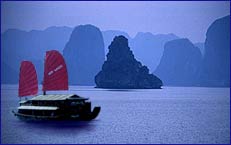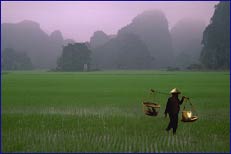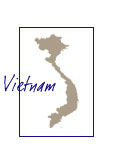
 |
|
Vietnam - A Country Divided
When one thinks of the people of Vietnam, one often envisions a boating people who live along the water and make their livelihood from the sea.  With over 2,000 miles of coastline, the majority of
people in Vietnam live on the lowland plains, within a few miles of the sea. Commonly seen
along this coast and its two rich delta areas are family owned sampans, basket boats, and large
fishing nets being cast in the sunset. Even markets are held by a gathering of boats along the
canals that run through some of the towns and cities.
With over 2,000 miles of coastline, the majority of
people in Vietnam live on the lowland plains, within a few miles of the sea. Commonly seen
along this coast and its two rich delta areas are family owned sampans, basket boats, and large
fishing nets being cast in the sunset. Even markets are held by a gathering of boats along the
canals that run through some of the towns and cities.
Vietnam has often been compared to two baskets of rice hanging on opposite ends of a pole. Northern Vietnam, with its Red River delta, is on one end, and is where the Viet people originally settled some 4,000 years ago. It is considered the cradle of the nation, and has always considered itself the ruling body over the more relaxed and easy-going southern Vietnamese.  The capital of Vietnam, Hanoi, is in the north. The Viet along the Red River delta
were subject to flooding and drought, and developed a sophisticated system of ancient canals
and dikes that still protect their villages and rice farms today.
The capital of Vietnam, Hanoi, is in the north. The Viet along the Red River delta
were subject to flooding and drought, and developed a sophisticated system of ancient canals
and dikes that still protect their villages and rice farms today.
Some 500 years ago, many of the Viet people in the north moved south and settled into the rich Mekong delta area. The Mekong River, running from Tibet down through the middle of the Indochina peninsula, is one of the world's greatest river systems. At the end of this river system sits Ho Chi Minh City, still commonly referred to as Saigon. Prior to the incursion by the Viet, south Vietnam was occupied predominately by the Cham and Khmer people. The Champa Kingdom was a highly civilized nation and was one of the earliest Hindu-influenced states of Indo-China. Today the matriarchal Cham people in Vietnam number less than 100,000 individuals.  The Khmer are the indigenous people of the Mekong Delta. While most of
the Khmer people are in Cambodia, there is a sizable minority in Vietnam. They are easily
distinguished from the Viet by their dark rounded faces and the checkered scarves they wear.
The Khmer are the indigenous people of the Mekong Delta. While most of
the Khmer people are in Cambodia, there is a sizable minority in Vietnam. They are easily
distinguished from the Viet by their dark rounded faces and the checkered scarves they wear.
In these two river deltas, Vietnam produces about 24 million tons of rice per year, and is the world's third largest exporter of rice. Villagers work together to produce the rice, and there are mythic legends associated with the growing of rice. Hill People Beyond the narrow coastal plain, Vietnam rises to rugged tropical mountains that house many different cultures of hill tribes. West of the Mekong Delta, they are commonly referred to by the French word Montagnard, meaning mountain dweller. There are some 54 different tribes in Vietnam, including Hmong, Mnong, Muong, Ede (or Rhade), and Jarai. It is the mountains that separates Vietnam from its neighbors, but the hill tribes often overlap the borders. In the north, the ethnic Yao have moved to different areas as war has driven them, but they maintain their traditions and the ways of their ancestors. They are said to have an ancient mythological link to the Chinese, chronicled during the Chinese Han Dynasty, and are said to be descendants of the Chinese Emperor Kao Hsin (2435-2345 B.C.E.). Struggle for Independence A fiercely independent people, the Vietnamese have fought invasions and colonizations and have struggled for independence. It is a land that has been victim to colonizations throughout its history. China, France, and the United States have all left indelible marks on the country, each adding its own slice of history to the Vietnamese culture. After 1,000 years of foreign domination, the Viet defeated the Chinese in the 10th century, and Vietnam became an independent state. The French colonized the country again during the mid-19th century, and Vietnam remained under French rule and influence until 1945. France set about on a "civilizing" mission, providing a lavish lifestyle for the French in Vietnam, while exploiting the Vietnamese workers. Japan seized control of Vietnam during World War II. In the years after being freed from the Japanese occupation after World War II, the Vietnamese, under the leadership of Ho Chi Minh, vehemently fought the Americans and later the Chinese for independence of the Democratic Republic of Vietnam. Handicrafts With the variety of ethnic people living in Vietnam, it is rich in cultural diversity. An industrious and hard working people, the Vietnamese cultures have produced an abundance of hand made and handicrafted items. From water puppets to beautiful embroidery, and from hand carved figures to lacquerware, the Vietnamese have applied their ingenuity to many artistic endeavors. Some of the handicrafts found in Vietnam are: Phu, Luc, & Tho Statue Phu, Luc, & Tho, three immortals who were originally brought to Vietnam by the Chinese, symbolize weath and abundance, happiness, and longevity. Silk Embroidered Pictures The colors of the silk thread must be carefully chosen to produce the delicate shades found in these beautiful embroidered pictures. The scenes depict pictures of Vietnamese life, sometimes on the vast river deltas, sometimes in the tropical farming villages. These embroidered pictures are meticulously done and the photos cannot display the sheen and beauty of the actual picture. Embroidered Tablecloths and Napkin Sets Hanoi embroidery is becoming world reknown for it beauty and artistry. These linen tablecloths and napkin sets reflect the beauty of the embroidery coming from Vietnam. Vietnamese Doll This Vietnamese doll is wearing the traditional Ao Dai costume as worn by Vietnamese women. Young women look youthful and innocent wearing their white Ao Dai, and the brilliant colors worn by married women truely sparkle. This doll is wearing the traditional Non, the Vietnamese conical palm leaf hat. Lacquerware Jewelry Boxes Lacquerware dating back to the fourth and fifth centuries B.C.E. have been found in graves in the Red River delta in northern Vietnam. It is believed that Vietnamese public officials visiting China observed the local villagers creating lacquerware art objects and brought the skill back to Vietnam. The art of lacquerware is very time consuming, since the traditional method calls for eleven coats of lacquer, each taking a week to dry and requiring a delicate sanding before applying the next layer. The mother of pearl shells for the inlay are carved with a tiny saw, and lines are engraved on the shell. In feudal times only noblemen could afford the lacquerware objects. Vietnamese Water Puppets Vietnamese water puppets have been portraying rural life in Vietnam for almost 1,000 years. Water puppet performances are still attracting audiences to theaters today from Hanoi to Ho Chi Minh City. Water puppetry is found nowhere in the world except Vietnam, and is being designated as part of the World's Cultural Heritage. Vietnamese Beaded Purse The delicate beadwork of these purses demonstrates the Vietnamese ability to produce exquisitely crafted items. The purses are completely covered with the decorative beads, and the detail is remarkable, giving these items an elegant look and feel. |

|
|||||||||||||||||||||||
Global Tradewinds Home
|
Customer Service
|
Contact Us
|
About Us © 2002-2008 Global Tradewinds, Inc. All rights reserved. |
|||||||||||||||||||||||||